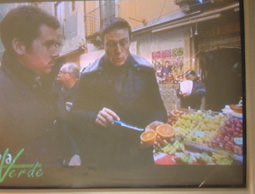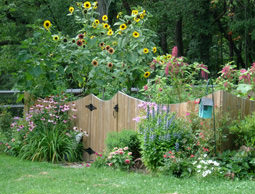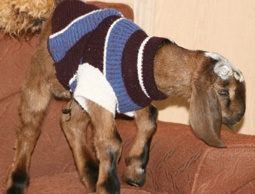 Because of its nitrogen-fixing ability, clover is a great companion plant for other crops. Clover also makes a great quality forage when mixed with grasses at a 1:3 ratio. |
A four-leaf clover symbolizes good luck, but you won’t have to rely on luck if you include clover in your farm grazing program. Clover is not only a great soil-building plant, it fixes nitrogen—which lowers the fertilizer bill—offers quality protein and creates highly palatable stands for grazing. On the proper sites with suitable weather conditions, certain varieties of clover can last years.
![]() Most varieties of clover make great companion crops for perennial grasses, such as orchard grass and fescue, and annual grasses, such as oats, wheat and ryegrass. Clover plants contain nitrogen-fixing nodules on the roots that take nitrogen from the atmosphere and fix it in a stable form in the decaying plant tissue. Surrounding companion grasses absorb this natural nitrogen through the roots, whether in the pasture, on crop land or in the backyard garden.
Most varieties of clover make great companion crops for perennial grasses, such as orchard grass and fescue, and annual grasses, such as oats, wheat and ryegrass. Clover plants contain nitrogen-fixing nodules on the roots that take nitrogen from the atmosphere and fix it in a stable form in the decaying plant tissue. Surrounding companion grasses absorb this natural nitrogen through the roots, whether in the pasture, on crop land or in the backyard garden.
Manufactured nitrogen has certain drawbacks that clover’s organic nitrogen does not. First, there’s the cost. Natural gas is used in the manufacturing of nitrogen-based fertilizer, and this accounts for three-quarters of the cost per ton. Second, manufactured nitrogen fertilizer can leach into groundwater, and the urea in some forms of nitrogen fertilizer can quickly evaporate into the atmosphere during hot weather, amounting to lost money and forage growth.
If rainfall is adequate and the weather is suitable, clover, when mixed with a companion grass, can fix enough nitrogen to supply the needs of both the clover and grasses without having to add manufactured nitrogen. On a typical pasture, the rule of thumb for mixing clover with grasses is 25 percent clover growing with 75 percent grasses.
Comparing Clover Plants
Knowing clover terminology helps when deciding on the right plants for your area. Perennial plantss have the potential to come back year after year, and annual plantss typically die after one year of growth. In many cases, the same clover plant variety may be an annual in one area of the country and a short-lived perennial in another. Under ideal conditions, even annual plants can come back for a few years. Warm-season legumes do the majority of their growing during warm weather, and cool-season legumes grow most during the cooler months. For pasture use, cool-season annual and perennial clovers give the highest returns in pasture quality.
Grow perennial clovers whenever possible to avoid replanting or reseeding. Among these varieties, white clover plants can live for several years and may also make seed that will thicken stands. Red clover plants can live as long as two years. However, in hot, drought-prone areas like the Deep South, these clovers may act as annual plants instead.
In such areas, annual clovers are a better choice than perennial cloverss because annuals make more growth than perennials in their establishment year. Although annual clovers die within 12 months, they may reseed if managed properly. As long as drought doesn’t get in the way, a key to long-term clover growth is timed mowing late in the growth season when the clover seed heads have matured. This will allow you to keep many of the weeds under control and disperse mature clover seed heads at the same time.
Perennial White Clover
White clover, recognized by its white, flowering seed head, is a workhorse for quality forage and nitrogen over a long period of time.
“A good stand of a perennial legume like white clover often produces 100 to 200 pounds of nitrogen per acre per year,” says Don Ball, extension agronomist with Auburn University. “Annual legumes, on the other hand, usually produce about 50 to 150 pounds of nitrogen per acre.”
With manufactured nitrogen reaching prices as high as $700 per ton, investment in a perennial such as white clover is money well spent in the long run, assuming white clover acts as a perennial plant in your area. Pasture managers can reduce fertilizer bills and maximize forage output.
Durana is a white clover variety that has proven itself for years as valuable forage that withstands hard grazing and handles hoof damage fairly well in pastures. In addition, this white perennial clover makes dependable growth in spring and autumn. The clover variety goes dormant in the heat of the summer, but a good rain in August will get it growing again. In many test plots, durana white clover has come back for as many as 12 years when weather conditions are ideal.
Red Clover
Red clover, sometimes referred to as cow clover, is distinguished by its pinkish, flowering seed heads. “Red clover is considered a short-lived perennial, but in the Deep South, it may act as an annual. In the Mid-south, red clover plants usually live for two years,” says Ball. “With both red and white clover, you can see production in spring and autumn in most states.”
Even though red clover plants don’t survive for as many years as white clover plants, they have advantages in the short run.
“Red clover gives the best year-long forage growth of any clover,” says Ball. “It starts growing in March and, if moisture is available, grows on into the summer. It’s very tolerant to heat during the summer.”
Red clover has good seedling vigor and usually establishes easily.
“Red clover is not tolerant of close, continual grazing by cattle,” says Ball. However, it performs well when planted in conjunction with rotational grazing of pastures with paddocks. This allows the plants to continue growing simply by growing more leaves to replace those bitten off during livestock grazing.
Page 1 | 2
















